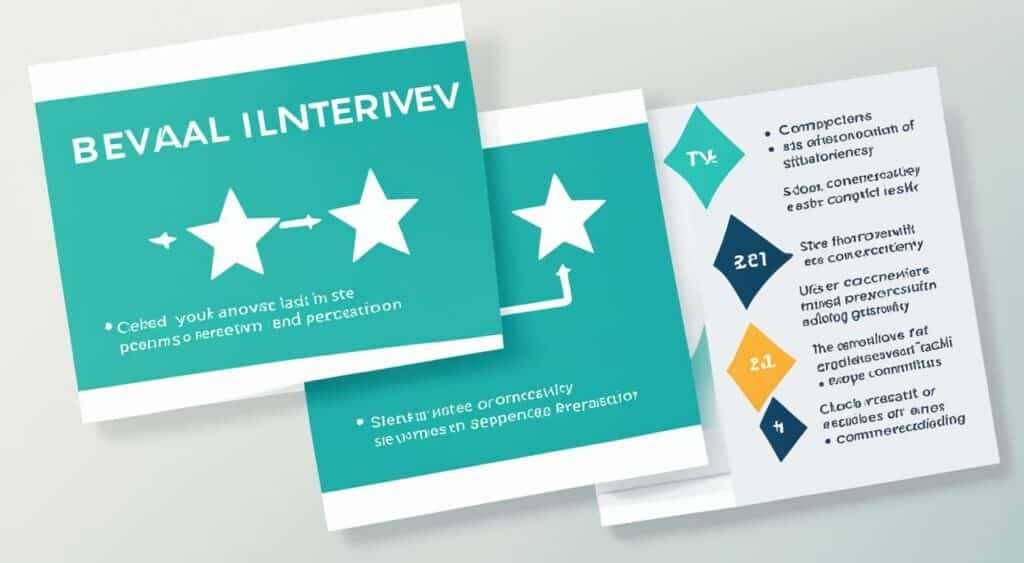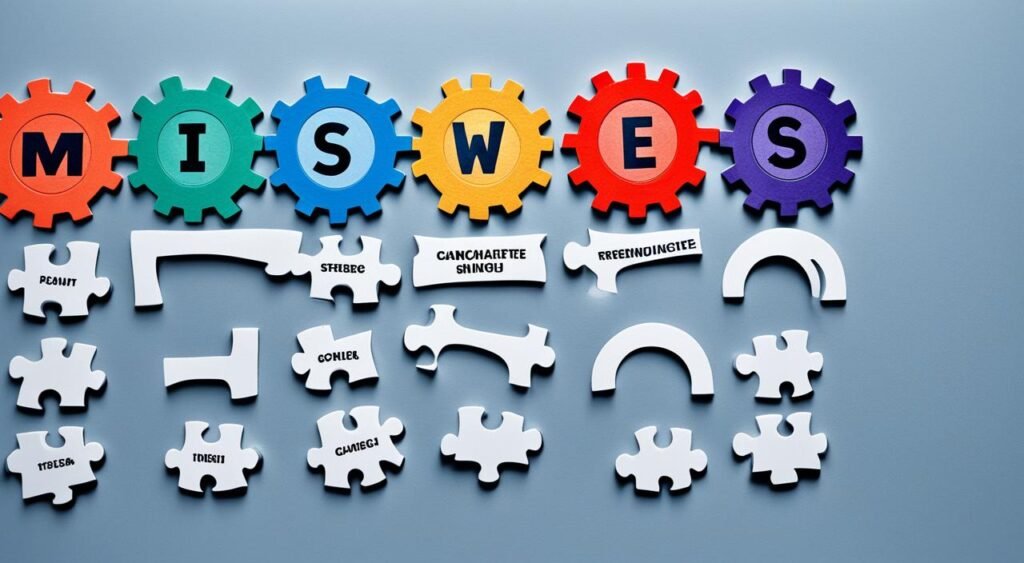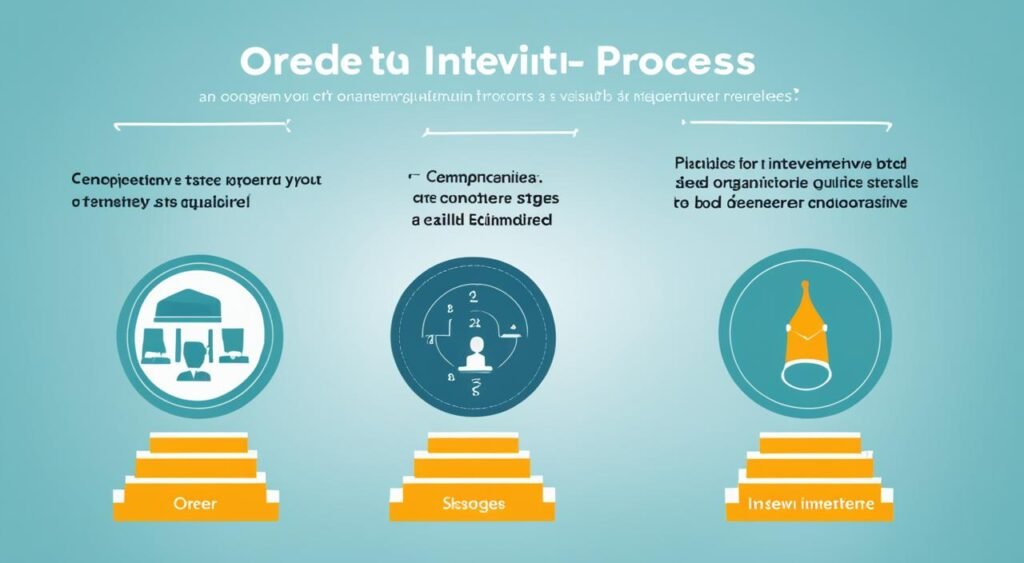Getting ready for a job interview is more than just looking the interviewer in the eyes. It includes having a set of questions to ask. The main goal is to make the whole process less scary for those looking for the job. At the same time, it’s about getting the right info to pick the best candidate fairly. You should teach your hiring group some key skills. These include using the STAR method to answer questions, really listening to what candidates say, and working well together during interviews.
Key Takeaways
- Effective interview techniques go beyond basic details like eye contact and prepared questions.
- The goal is to make the interview process less nerve-wracking for job seekers while gathering the necessary information to make informed, unbiased hiring decisions.
- Hiring teams should be trained on behavioral interviewing, including the STAR method for answering questions.
- Active listening and coordination among the hiring team are crucial for a successful interview process.
- Identifying key behaviors and skills for the role, as well as creating scenarios to showcase candidate abilities, are important interview techniques.
Also Read : What Are The Essential Nutrients For A Healthy Diet?
Maintaining Eye Contact and Positive Body Language
At a job interview, effective communication is not just about talking. Your non-verbal cues and body language can impress employers greatly. It’s vital to keep strong eye contact and have positive body language all through the interview. This shows your interview presence and first impressions.
Also Read : What Are The Best Exercises For A Daily Workout?
The Importance of Non-Verbal Cues in Interviews
How you act is as important as what you say. Your active listening and problem-solving skills show through. Concentrating on the interviewer helps you notice non-verbal cues. These clues can share insights into your thinking and how you make choices.
Open body language is key. Face your interviewer, keep your arms uncrossed, and be interested. This shows you are engaged and enthusiastic about the job. On the other hand, if you show closed-off or fidgety body language, it might signify you’re nervous or not confident about the job.
Also Read : How Can You Prevent Chikungunya ?
| Positive Body Language | Negative Body Language |
|---|---|
|
|
Think about your body language and non-verbal communication carefully. It can show you are confident, eager, and truly want to connect with the interviewer. This can really boost your interview presence and your opportunity for making a great impression.
Also Read : What Are The Health Benefits Of Cycling Regularly?
Preparing a List of Questions

Making a good list of questions is key when getting ready for an interview. These questions need to check the skills, experiences, and if the person fits culturally for the job. Use a mix of questions like “Tell me about yourself,” behavioral questions, and competency-based questions to get the best information.
Also Read : Exploring PHD Scholarship Opportunities In 2024
Think about what questions you want to ask. It should include:
- Open-ended questions let the candidate talk about their background and experiences.
- Behavioral questions show how the candidate dealt with situations before, showing their problem-solving and decision-making.
- Competency-based questions check the candidate’s skills for the job.
- Scenario-based questions ask how they would handle different situations.
- Informational interviews learn about the candidate’s interests, values, and goals.
With a full list of questions, your interview can be really thorough. This way, you get the details you need to make a smart choice.
“The quality of your questions determines the quality of your answers.” – Jim Rohn
Interview Techniques for Behavioral and Competency-Based Questions

Behavioral and competency-based interview questions are great for evaluating a candidate. They provide insight into their past work and future potential. These questions are about past situations. They aim to understand a candidate’s problem-solving skills, decision making, and positive outcomes they achieved.
Teaching the STAR Method for Answering Behavioral Questions
To maximize the value of these interviews, it’s vital to teach the STAR method. This method helps candidates give detailed, real-life examples of their skills. Interviewers can then understand the candidate’s fit for the job better by how they structure their answers.
- Situation: The candidate describes the specific context or problem they faced.
- Task: The candidate explains their role and the objectives they needed to accomplish.
- Action: The candidate details the steps they took to address the situation and achieve the desired outcome.
- Result: The candidate shares the positive outcome or learning experience that resulted from their actions.
Using the STAR method lets your interview team get better answers from candidates. This approach helps in both behavioral interviews and competency-based interviews. It not only helps the candidate but also gives interviewers a clear way to judge a candidate’s skills and stories.
“The STAR method is a powerful tool for candidates to showcase their experiences and for interviewers to gain deeper insights into a person’s potential fit for the role.”
Allowing Candidates to Speak and Elaborate

Effective interviews strike a balance. They mix the interviewer’s questions with the candidate’s detailed answers. A key interview technique to achieve this is to let the candidates talk and expand on their thoughts.
Interviewers can sometimes ask too many questions too quickly. This doesn’t leave space for the candidate to fully share their thoughts and experiences. Just a brief pause after a question can open up the conversation. It makes the atmosphere more relaxed. This allows the candidate to share detailed and authentic responses without feeling rushed.
This method encourages active listening from the interviewer. It also paves the way for specific follow-up questions. These follow-ups can dig deeper into the candidate’s skills and suitability for the job.
“The most common way people give up their power is by thinking they don’t have any.” – Alice Walker
In the end, letting candidates talk is a game-changer. It makes the interview experience better for everyone involved. Both the interviewer and the candidate benefit from a more informative and engaging conversation.
The Benefits of Open-Ended Questions
Open-ended questions shape a space where conversation flows freely. They go beyond yes or no answers. They shed light on a candidate’s problem-solving and critical thinking skills, as well as how well they fit the job. By letting candidates expand in their responses, interviewers dive deep into their experiences.
| Open-Ended Question | Closed-Ended Question |
|---|---|
| Tell me about a time when you had to solve a complex problem at work. | Have you ever solved a complex problem at work? |
| Can you describe your approach to project management and how you ensure tasks are completed on time? | Do you have experience with project management? |
| What do you find most rewarding about working in a team environment? | Do you prefer working in a team or independently? |
Using open-ended and follow-up questions together gives a clearer picture of the candidate. It helps interviewers to better evaluate their abilities. This approach contributes to making more informed decisions when hiring.
Identifying Key Behaviors and Skills for the Role
Before starting interviews, it’s key for the hiring group to work together. They should identify what traits, skills, and knowledge are needed for the position. This groundwork makes sure the interview questions focus on what’s important, helping assess if a candidate is a good fit.
Coordinating Interview Questions with the Hiring Team
The hiring team needs to plan who will ask about what during the interview. This makes the process smoother and more effective. Such preparation makes the interviews better for everyone and leads to smarter hiring choices.
By doing a thorough job analysis and competency mapping, the team spots the crucial skills and knowledge needed. They then tailor interview questions to these needs. This approach gives them a clear view of how each candidate fits the role.
Working together as a team is crucial in creating the interview setup. This setup accurately gauges important job-relevant skills and candidate evaluation. It helps pick the best-suited people for the job.
“Coordinating the interview process with the hiring team is crucial to ensuring we identify the right candidate for the job. By aligning our questions with the key behaviors and skills required, we can make more informed and consistent hiring decisions.”
Allocating Tasks Based on Candidate Experience
One powerful way for hiring managers to conduct interviews is by assigning specific tasks or scenarios based on a candidate’s background. This is the task-based interview approach. It lets interviewers see how a candidate might tackle real-life issues linked to the job. This way, they can understand the candidate’s thinking, problem-solving skills, and potential to grow.
Tailoring interviews to each candidate helps hiring teams find hidden strengths and spot chances for career growth. This approach is more personalized than the usual candidate assessment methods. It makes picking the right person for the job more informed.
- Identify the key role-specific skills and duties the job requires.
- Look at each candidate’s resume to see their experience and skills.
- Create tasks or scenarios that relate to the job and test the candidate’s problem-solving.
- Watch how the candidate approaches the tasks and solves problems.
- Assess how well the candidate fits the job and their potential for career advancement.
“Task-based interviews allow us to see how candidates would handle real work, helping us hire better.”
Using this task-based interview method can help hiring teams truly understand a candidate’s skills and potential. It can lead to hiring people who will help the organization succeed over time.
Creating Scenarios to Showcase Candidate Skills
Looking for the top candidate now means looking past simple interview questions. Savvy hiring teams are using custom scenarios and mini-projects. This lets job seekers show off their skills, solve problems, and think well under pressure.
These activities are key in seeing what a candidate can really do. They look at technical skills, how creative someone is, and if they fit the job well. It’s like putting them to work on real challenges to see how they do.
Job simulations and work samples in interviews offer so much. They help find skills that might not show on a resume. They also point to people who could take the job further, showing they can grow and learn.
When making these candidate skills assessment tasks, it’s important to aim for the job’s exact needs. This means the job offers are based on real, useful information. That way, decisions are smarter and backed by data.
Adding problem-solving and critical thinking tests to interviews is powerful. It lets employers see more of what a candidate can do. This leads to hires who fit better and a team that works well together.
“Hands-on exercises give candidates the opportunity to showcase their technical capabilities, creativity, and ability to think critically under pressure.”
Focusing on Candidate Strengths and Passion

In the hiring world, the best interviewers look beyond a candidate’s flaws. They aim to understand the individual’s strengths and passions. By starting with questions that let candidates talk about what they’ve achieved, their skills, and what drives them, interviewers get crucial information.
This method makes candidates feel better and more involved. It also helps see how well they might do in the long run. Letting candidates highlight their strengths can make them feel good and excited about the job. This boosts how well they fit with the company.
Furthermore, knowing what a candidate dreams of and what fuels their passion helps hiring teams. It allows them to gauge how well a candidate would fit with the company’s goals and values. Such an approach helps find out more than just their job skills. It reveals if they’re likely to grow and help the company succeed.
“The best interviewers focus on understanding a candidate’s natural strengths and passions, rather than solely dwelling on their weaknesses. This approach often leads to better hiring decisions and more engaged, high-performing employees.”
Choosing a strengths-based interview style helps hiring managers see deeper into a candidate’s potential. This leads to smarter hiring choices. These choices are good for the company and its people.
Assessing Critical Thinking and Problem-Solving Skills

Evaluating a person’s critical thinking and problem-solving skills is key. It shows how likely they are to excel in a job. By giving them complex problems to work on, interviewers can see their thinking process. This helps understand their decision-making, thinking, and how flexible they are, all important for success.
Good interviews test more than just past experiences. They make candidates think quickly and tackle hard issues. This shows their analytical skills and how they deal with tough situations. It also highlights their creativity and ability to work without clear answers.
- Pose open-ended questions to make candidates think from different angles.
- Give them a task with missing parts and see how they solve it.
- Ask them to talk through their problem-solving process to understand their thinking.
- Test their ability to handle surprises and solve problems on the spot.
Adding these types of interviews to the recruitment process is smart. It offers a deeper look at what candidates can do and their potential in the job. Such an approach finds the best people and prepares them for the job’s real challenges.
“The true measure of intelligence is not knowledge but imagination.”
— Albert Einstein
Checking for critical thinking skills during interviews is vital for a strong team. It ensures that new hires can handle whatever comes at them. This focus helps organizations pick the right people and prepares them for lasting success.
Structured, Competency-Based Interviewing

Using a competency-based interviewing system ensures interviews are consistent and objective. It means designing questions to check if candidates have the needed skills. Everyone gets asked the same questions, making it fair. This way, teams can work together better to choose the right person for the job.
Taking part in a structured interview helps everyone to understand candidates the same way. It relies on specific questions about what skills the job needs. This makes sure decisions are fair and based on facts rather than just personal feelings.
Competency-based hiring means everyone rates candidates using the same questions. This makes it fairer and easier to compare results. Everyone gets looked at using the job’s real needs to make better choices on who to hire.
By using a structured, competency-based interviewing system, companies create a smarter hiring process standardization. They get to choose better matches, leading to fewer people leaving. The result is a smoother, more effective hiring experience for everyone involved.
“Structured interviews are a powerful tool for ensuring that the hiring process is fair, objective, and focused on the key competencies required for the role.”
Also Read : Ace Your Next Job With Expert Interview Coaching
Tackling Negatives and Weaknesses Head-On
Interviewers know dealing with a candidate’s weaknesses is important. They understand that everyone has faults. How candidates talk about their past errors shows a lot. It shows how they’ve learned and grown. This helps interviewers see how aware and able a candidate is, fitting for the job.
Looking at a candidate’s weaknesses openly shows that interviewers want to see their real ability. It leads to honest conversations. Candidates are more likely to talk about what they’ve learned from mistakes. They become okay with talking about ways to get better.
The Benefits of Tackling Weaknesses
- They can learn about how well a candidate knows their strengths and flaws.
- It helps see their problem-solving skills and lessons from their past.
- They can tell if a candidate is always looking to be better.
- It highlights areas for growth and the candidate’s plans to improve.
If interviewers face weaknesses directly, it makes talks more open and useful. It’s good for both the interviewer and the candidate. The candidate gets to show they understand themselves and can solve problems. This makes the interview process clearer and more valuable for everyone.
“The greatest weapon against stress is our ability to choose one thought over another.” – William James
| Strength | Weakness | How to Address |
|---|---|---|
| Strong analytical skills | Occasionally struggle with work-life balance | Talk about how to balance work and life, like using good time management. Also, put focus on self-care. |
| Excellent attention to detail | Can be overly critical of my own work | Explain how detailed work helps, and how you balance it with being kind to yourself. Mention how you share tasks. |
| Collaborative nature | Can be hesitant to give critical feedback | Tell about getting better at giving good feedback. And keeping a positive team bond while doing so. |
Interview Techniques

Learning interview best practices is vital for companies seeking top talent. It involves creating a good connection with candidates and listening well. Also, asking the right questions is key. This approach helps find the best fit for the job and enriches the candidate experience. It’s all about forming a strong team through good talent acquisition strategies.
Making eye contact and using positive body language are big parts of a successful interview. How you act speaks volumes to the person being interviewed. It can make them feel more at ease and engaged.
Having a clear list of questions ready is a must. These should help you gauge the candidate’s skills and how they’d fit the position. Adding questions that focus on behavior and competencies offers a deeper look into the candidate’s abilities.
It’s crucial that the interview setting lets candidates feel at ease talking about themselves. Actively listening and asking more about their answers helps. This gives applicants the chance to really shine.
Choosing questions that highlight the crucial behaviors and skills needed for the job is essential. It helps the interview stay on track and ensures candidates are evaluated fairly.
Also, including situations or tasks that test their problem-solving and thinking abilities offers a clear view of their potential.
Using these interview best practices well can improve how candidates view your company. It also helps in making smart choices when hiring. Your team will be stronger for it, supporting your talent acquisition strategies.
“The key to successful hiring is to find candidates who will thrive in the role and contribute to the company’s overall success.” – John Doe, HR Manager
Conclusion
Effective interviewing is key when looking for great talent. By using smart interview methods, your team can make better hiring choices. This will help you get top-notch employees who do great work.
Having a clear way to evaluate people is crucial. Making sure all candidates are measured on the same skills and behaviors is important. Also, helping your team listen well and understand a candidate’s problem-solving skills is a must.
Interviews should feel good for both the interviewer and the candidate. It’s about making sure the experience is positive while also getting the info you need. With the right interviewing approaches, you can make your hiring process smooth and effective. This includes using the best methods in hiring, talent spotting, and finding out what makes a great job search.





